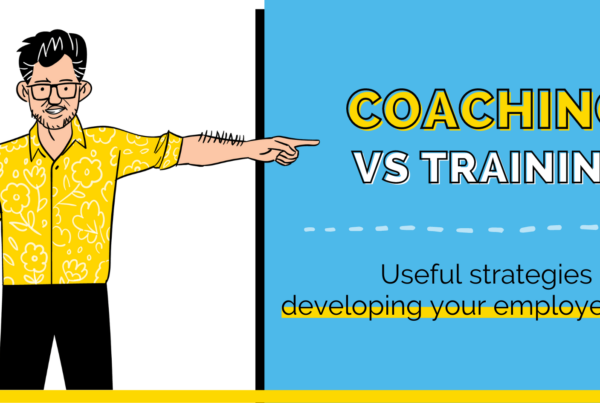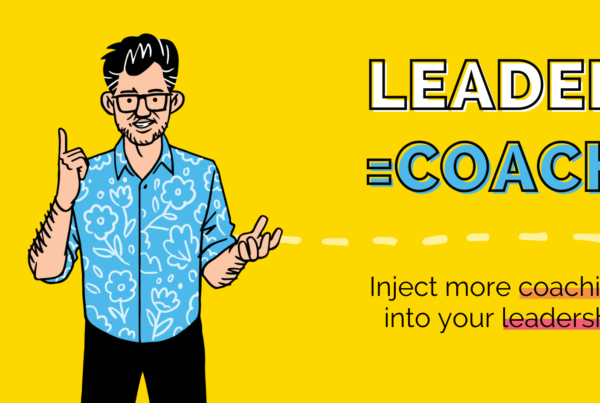
So, you’ve heard that this coaching malarkey can really improve your team’s performance, but you’re a little skeptical (to say the least).
Perhaps you’ve dismissed coaching, thinking, “That’s more for the HR people. I’ve got a real job to do.”
Or you’ve done a little research, and the multitude of coaching approaches—performance, executive, career, development—seems overwhelming.
Or, maybe, the time factor is holding you back. You’ve just become a manager and you’re too busy and too stressed to add coaching into your schedule.
Well, let me ask you a few questions:
- Do you want the people on your team to grow, learn, and reach optimum work performance?
- Do you want them to be able to come up with their solutions, instead of rushing to you every time they face a challenge?
- Do you want to be able to focus on your work, instead of feeling overwhelmed by everyone else’s?
- Do you want to reignite the zest and joy you once felt for your job?
If you answered yes, yes, yes, and yes, then coaching for development is the answer you’re looking for.
The Greatest Answers Come From the Greatest Questions
Become a better leader. Better teacher. Better person.
Learn how to ask the right questions the right way with this free download.
Eight Ways to Ask a Question Well
But What About Performance Coaching?
Before we dive into coaching for development, let’s first look at a common misnomer in the coaching world – coaching for performance or performance coaching.
At first glance, performance coaching sounds like the ideal solution for boosting team performance. After all, it’s in the name!
But, in reality, performance coaching is narrow in its focus. It’s about addressing a particular issue with your employee, with the goal of solving it. Issues at work come up constantly, so there’s no way to get around this kind of coaching — it will always be a necessary and important aspect of your job.
But, coaching for performance isn’t going to drive the kind of transformational change that leads to a more independent, capable, and confident team.
Think of it this way – imagine that the issue your employee raises is a fire that’s getting slightly out of control. With coaching for performance, you’re the one putting out the fire. Your employee might learn a little bit from the experience, but you haven’t empowered them to extinguish the flames for themself.
Coaching for development, on the other hand, does just that.
What Is Development Coaching?
If performance coaching is all about putting out fires, then coaching for development is about turning the focus from the fire to the person who’s managing it.
Rather than rushing in to fix things and save the day, you’re encouraging the other person to come up with their own solution by asking them questions.
Essentially, you’re shifting the responsibility for figuring stuff out and getting stuff done back to the other person involved.
While it might be a little awkward and uncomfortable to subvert the power dynamic at first, it’s only by inviting people to take full responsibility for their work that they learn, grow, and unlock their greatness.
Coaching for development also has a ton of juicy benefits for you. See, engaging with others in this way is kind of like upgrading to a new phone. Your team will build new skills, increase their capacity, and boost their capabilities – it’s almost like they’ll start rewiring themselves to become bolder, brighter, and better.
How Can Coaching Improve Team Performance?
Working less hard and having more impact sounds delightful in theory. But what does it actually look like in practice? Here’s a look at just some of the benefits you’ll unleash:
1. Improved Communication Skills
It’s all too enticing to believe that effective communication revolves around sharing our cherished insights, golden nuggets, insightful diamonds – our hard-earned life advice.
However, the crux of communicating better lies not in verbosity but in the art of asking thoughtful questions – it’s actually the cornerstone of coaching for development.
Only when we’re generous with curiosity (and equally generous with its counterpart, silence) can we make people feel seen, heard, and understood.
2. Enhanced Time Management
I divide work into three categories:
- Bad work. This is pointless bureaucracy. It’s the kind of work that drains your time and energy.
- Good work. This is important work. It’s your job description. But it doesn’t excite you or stretch you.
- Great work. This is the work that’s meaningful and important, and makes a difference.
Unfortunately, a lot of managers are swamped with bad work, with little time to do strategic great work.
Coaching can help in two game-changing ways:
- It nurtures a sense of independence and autonomy in your team, meaning you’ll get to carve out more time and space to focus on the stuff that matters to you.
- Coaching questions like “If you’re saying yes to this, what must you say no to?” and “What is the real challenge here for you?” directly help your people to sift through their priorities so they can, in turn, cut out the busywork and do more of the work that has an impact.
3. Boosted Motivation
We all know that a disengaged workforce is not a productive one. While you might think office perks and bonuses are the golden ticket to amping up your team’s performance, Dan Pink’s excellent book Drive shows us that it’s three intrinsic factors that spark motivation – autonomy, mastery, and purpose.
Coaching plays to this trifecta of drivers wonderfully. There’s nothing like a delightful question to boost autonomy (certainly), mastery (probably), and purpose (possibly).
But don’t just take my word for it – as this Harvard Business Review article shows, effective coaching is a powerful, proven way to boost business success.
Tips to Improve Team Performance as a Coach-Like Manager
Eager and itching to unlock your team’s greatness through coaching? Here’s what you need to do to get started:
1. Cultivate a Coaching-Oriented Environment Through Curiosity
The rocket fuel of coaching for development is this simple habit – slow down the rush to give advice and stay curious a little longer.
Why?
For starters, your advice is not as good as you think it is. You’ll probably dive headfirst into resolving the wrong problem, viewed through a foggy lens of biases and incomplete information.
More troublingly still, offering up advice prematurely undermines the growth and confidence of the person you’re talking to.
So, next time someone comes to you with an issue, lean into curiosity instead and ask a question.
For the most part, you can start questions with one of three words – what, how, or why. I have a soft spot for ‘what’ questions because they evoke the most genuine curiosity.
Here are a few of my favorites questions from my book, The Coaching Habit:
- What’s on your mind?
- What do you (really) want (from me)?
- What was most useful for you?
2. Embrace the Awkwardness
So, you’ve managed to resist your advice monster and opted for a thoughtful question instead.
Here’s your next move – embrace the power of silence.
I won’t sugarcoat it – it’s going to feel a bit awkward, and you might even feel an overwhelming urge to fill the silence with almost any words you can think of.
Even so, stay quiet. That period of silence – albeit uncomfortable – is a delightful gift to the other person.
You’re giving them the space to be with themselves, for you to be with them, for presence to show up. It allows them to take a breath. It whispers, “This is an interesting place to be. Let’s hang out here for a moment.”
So, ask the question, then zip it. Don’t let the discomfort of a heartbeat or two of awkwardness get in the way of them stepping into their potential.
3. Make Coaching an Everyday Interaction
Even while proclaiming the value of coaching employees in his seminal article, Daniel Goleman shrugged his shoulders and said, “Many leaders told us they don’t have the time in this high-pressure economy for the slow and tedious work of teaching people and helping them grow.”
And don’t forget, this was back in the halcyon days of 2000 when we were less connected and less overwhelmed, and less distracted than we are today.
The “no time” perception is pervasive, and it’s often cited by managers as the primary reason they shy away from coaching.
Contrary to this belief, coaching shouldn’t require you to carve out extensive chunks of time. It’s an informal, day-to-day interaction that takes 10 minutes or less. Whether in person, over the phone, via Zoom, on Slack, or through email – any interaction is an opportunity to stay curious just a bit longer.
Remember, this isn’t about ‘becoming’ a coach or adding to your workload – it’s about transforming what you already do to become more coach-like.
4. Build Relationships Based on Fierce Love
I define my coaching philosophy in two words – fierce love.
Fierce in this equation means you’re willing to do what it takes to challenge, push, and provoke your team to be the best they can be.
Love in that you’ll always remember and champion the human behind the task. You’ll wholeheartedly support them, help them bounce back from failure, and assume positive intent.
By infusing fierce love into your coaching approach, you’ll not only nurture a resilient, effective team but, at the individual level, you’ll help each of the people you lead unearth more love and oomph for the work they do.
5. Be Generous With Support and Encouragement
Despite my mum’s audible disapproval of the phrase, I consistently wrap up my emails with: “You’re awesome and you’re doing great.”
There’s a reason for that. As human beings, We all crave acknowledgement that we matter and that we’re doing a good job.
In fact, in her brilliant book, The Progress Principle, Theresa Amabil, and her researchers found that celebrating small wins is the secret to motivating employees to reach major accomplishments.
So, as well as building your coaching muscle, strengthen your encouragement muscle too.
Make it a habit to celebrate success, give credit where credit is due, and remind people of their worthiness. You’ll be astounded at just how quickly their work performance catapults towards greatness.
6. Get Good at Giving the Gift of Feedback
Giving constructive feedback is crucial to helping your people grow and learn. But the whole “giving feedback” thing is much easier to say than to do.
There’s a reason for that: your – and their – amygdala. Whether you’re giving or receiving feedback, your brain’s going to freak out a little. And by freak out, I mean beat a retreat to the lizard brain, where the focus is survival.
Fight or flight, things getting more black and white, assuming the worst, a narrowing of vision and focus – all of these are great survival tools. However, all are often less than useful in a frank, open, and generous conversation.
Knowing about this phenomenon helps. You can focus on your physiology, and watching your stress response can help you manage it.
But before you even get to the meeting, first explore your feedback in the context of Marshall Rosenberg’s model of non-violent communication technique. He states that all communication has four aspects – the data, your feelings, your judgments, and what you want or need.
Whenever it’s time to share feedback with your team, it’s really useful to magnify the data and what you want and minimize your judgments and feelings. That way, you’ll be objective and fair to the person across from you.
7. Raise the TERA Quotient
According to neuroscience, our brains scan their surroundings every five seconds and ask: “Is it safe here, or am I in danger?”
When the brain feels safe, we unlock optimum performance. We’re creative, bold, enthusiastic. Our best, true selves.
But the moment the brain senses danger, our atavistic brain takes hold. We’re afraid, we’re disengaged and we’re on the defense.
For your coaching habit to have an impact, you’ll want your people to see working with you as a place of reward, not risk. To do that, leverage the TERA quotient to build workplace trust.
- T – tribe: “Are you with me or against me?;”
- E – expectation: “Do I know what is going to happen or do I not know what is going to happen?”
- R – rank: “Do I feel more or less important than you?;”
- A – autonomy: “Do I have some choice here or are you making the choices for me?”
To be a great leader, try to raise the TERA quotient whenever possible.
What is the best way to do it?
Asking a good question.
8. Tailor Coaching Activities to Individual Needs
Every person on your team is an individual, so it makes sense that your coaching approach caters to their idiosyncrasies. Some people, for example, love to be pushed out of their comfort zones, while others require more psychological safety.
To discover who your team members are and what they need, you’ll need to have a frank and open conversation. Specifically, the Keystone Conversation – a radical, powerful discussion with your direct report about how you’ll work together, rather than what you work on.
You can learn more about how to have the Keystone Conversation in my latest book, How to Work With (Almost) Anyone, but here are a few simple questions to get you started:
- What does it look like when you’re working at your best?
- What are your practices and preferences?
- How do you like to receive feedback?
Say Less, Ask More, and Change the Way You Lead Forever
If you’re a manager yet to dip your toe into the world of coaching, consider this your wake-up call.
Start building your coaching habit for yourself and the people you lead.
Hungry for a deeper dive?
The Coaching Habit gives you 7 questions and the tools to make them an everyday habit.




